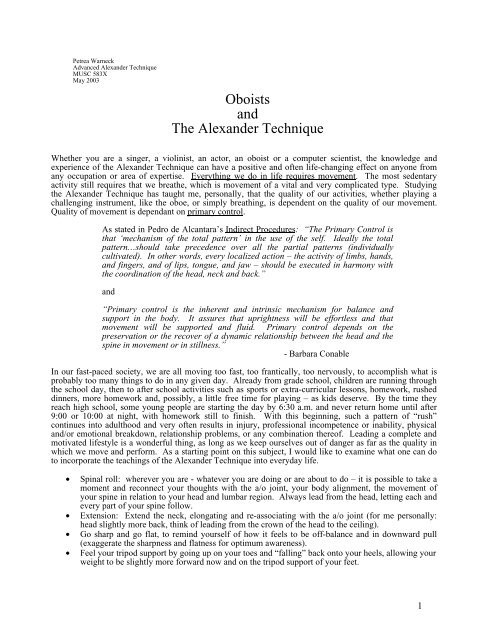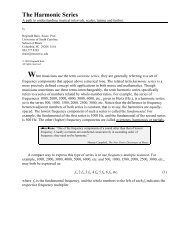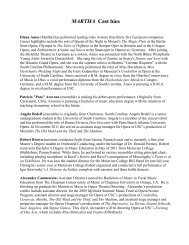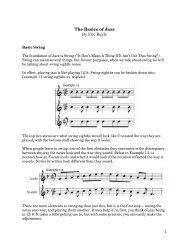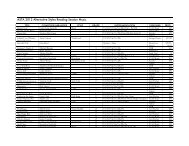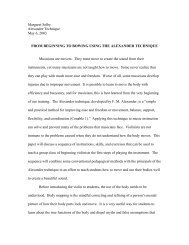Oboists and The Alexander Technique - USC School of Music
Oboists and The Alexander Technique - USC School of Music
Oboists and The Alexander Technique - USC School of Music
You also want an ePaper? Increase the reach of your titles
YUMPU automatically turns print PDFs into web optimized ePapers that Google loves.
Petrea Warneck<br />
Advanced Alex<strong>and</strong>er <strong>Technique</strong><br />
M<strong>USC</strong> 583X<br />
May 2003<br />
<strong>Oboists</strong><br />
<strong>and</strong><br />
<strong>The</strong> Alex<strong>and</strong>er <strong>Technique</strong><br />
Whether you are a singer, a violinist, an actor, an oboist or a computer scientist, the knowledge <strong>and</strong><br />
experience <strong>of</strong> the Alex<strong>and</strong>er <strong>Technique</strong> can have a positive <strong>and</strong> <strong>of</strong>ten life-changing effect on anyone from<br />
any occupation or area <strong>of</strong> expertise. Everything we do in life requires movement. <strong>The</strong> most sedentary<br />
activity still requires that we breathe, which is movement <strong>of</strong> a vital <strong>and</strong> very complicated type. Studying<br />
the Alex<strong>and</strong>er <strong>Technique</strong> has taught me, personally, that the quality <strong>of</strong> our activities, whether playing a<br />
challenging instrument, like the oboe, or simply breathing, is dependent on the quality <strong>of</strong> our movement.<br />
Quality <strong>of</strong> movement is dependant on primary control.<br />
As stated in Pedro de Alcantara’s Indirect Procedures: “<strong>The</strong> Primary Control is<br />
that ‘mechanism <strong>of</strong> the total pattern’ in the use <strong>of</strong> the self. Ideally the total<br />
pattern…should take precedence over all the partial patterns (individually<br />
cultivated). In other words, every localized action – the activity <strong>of</strong> limbs, h<strong>and</strong>s,<br />
<strong>and</strong> fingers, <strong>and</strong> <strong>of</strong> lips, tongue, <strong>and</strong> jaw – should be executed in harmony with<br />
the coordination <strong>of</strong> the head, neck <strong>and</strong> back.”<br />
<strong>and</strong><br />
“Primary control is the inherent <strong>and</strong> intrinsic mechanism for balance <strong>and</strong><br />
support in the body. It assures that uprightness will be effortless <strong>and</strong> that<br />
movement will be supported <strong>and</strong> fluid. Primary control depends on the<br />
preservation or the recover <strong>of</strong> a dynamic relationship between the head <strong>and</strong> the<br />
spine in movement or in stillness.”<br />
- Barbara Conable<br />
In our fast-paced society, we are all moving too fast, too frantically, too nervously, to accomplish what is<br />
probably too many things to do in any given day. Already from grade school, children are running through<br />
the school day, then to after school activities such as sports or extra-curricular lessons, homework, rushed<br />
dinners, more homework <strong>and</strong>, possibly, a little free time for playing – as kids deserve. By the time they<br />
reach high school, some young people are starting the day by 6:30 a.m. <strong>and</strong> never return home until after<br />
9:00 or 10:00 at night, with homework still to finish. With this beginning, such a pattern <strong>of</strong> “rush”<br />
continues into adulthood <strong>and</strong> very <strong>of</strong>ten results in injury, pr<strong>of</strong>essional incompetence or inability, physical<br />
<strong>and</strong>/or emotional breakdown, relationship problems, or any combination there<strong>of</strong>. Leading a complete <strong>and</strong><br />
motivated lifestyle is a wonderful thing, as long as we keep ourselves out <strong>of</strong> danger as far as the quality in<br />
which we move <strong>and</strong> perform. As a starting point on this subject, I would like to examine what one can do<br />
to incorporate the teachings <strong>of</strong> the Alex<strong>and</strong>er <strong>Technique</strong> into everyday life.<br />
• Spinal roll: wherever you are - whatever you are doing or are about to do – it is possible to take a<br />
moment <strong>and</strong> reconnect your thoughts with the a/o joint, your body alignment, the movement <strong>of</strong><br />
your spine in relation to your head <strong>and</strong> lumbar region. Always lead from the head, letting each <strong>and</strong><br />
every part <strong>of</strong> your spine follow.<br />
• Extension: Extend the neck, elongating <strong>and</strong> re-associating with the a/o joint (for me personally:<br />
head slightly more back, think <strong>of</strong> leading from the crown <strong>of</strong> the head to the ceiling).<br />
• Go sharp <strong>and</strong> go flat, to remind yourself <strong>of</strong> how it feels to be <strong>of</strong>f-balance <strong>and</strong> in downward pull<br />
(exaggerate the sharpness <strong>and</strong> flatness for optimum awareness).<br />
• Feel your tripod support by going up on your toes <strong>and</strong> “falling” back onto your heels, allowing your<br />
weight to be slightly more forward now <strong>and</strong> on the tripod support <strong>of</strong> your feet.<br />
1
• Lie down on the floor <strong>and</strong> allow yourself at least 5 minutes <strong>of</strong> constructive rest. Allow yourself<br />
this!<br />
• Breathe………….breathe…………….breathe…………………<br />
• Especially when there is cause for tension or angst, take a moment <strong>and</strong> practice some deep<br />
breathing, whispered “Ah”, speaking or singing words that are comforting to you or that relax your<br />
jaw, tongue, face <strong>and</strong> neck. Create pleasant images with these pleasant words.<br />
Following are a few suggestions <strong>and</strong> basic goals to keep in mind while studying the teachings <strong>of</strong> Alex<strong>and</strong>er:<br />
• Develop a knowledge <strong>of</strong> the anatomy for accurate body mapping.<br />
• Use the re-alignment, balance, buoyancy <strong>and</strong> relationship <strong>of</strong> the a/o joint, neck <strong>and</strong> spine to<br />
eliminate all forms <strong>of</strong> stress, performance anxiety, muscle tension <strong>and</strong> cramping, loss <strong>of</strong> primary<br />
control.<br />
• Focus <strong>and</strong> find a place <strong>of</strong> centeredness, being grounded, both during performance <strong>and</strong> in dealing<br />
(both pr<strong>of</strong>essionally <strong>and</strong> personally) with other people in your life.<br />
• Initiate <strong>and</strong> create all forms <strong>of</strong> movement in conjunction with breathing.<br />
• Eliminate your own usage <strong>of</strong> words that have negative connotation, whether in your teaching<br />
or in your everyday speaking.<br />
• Strive for awareness about your body <strong>and</strong> the quality <strong>of</strong> your movement.<br />
• Determine methods that work for you, for evaluating your own movement.<br />
• Through your self-evaluation <strong>and</strong> awareness, you will be better equipped to help others:<br />
observe the movement <strong>of</strong> everyone around you <strong>and</strong> teach yourself to recognize the difference<br />
between natural, balanced, breathing movement <strong>and</strong> movement which lacks primary control,<br />
balance <strong>and</strong> freedom.<br />
All <strong>of</strong> the above mentioned points have made a difference in my oboe playing, my performance<br />
style, my personal growth as a person <strong>and</strong> as a musician, <strong>and</strong> in my ability to be a successful<br />
teacher. In the following paragraphs I will address specific issues <strong>of</strong> playing <strong>and</strong>/or teaching the<br />
oboe, <strong>and</strong> how incorporation <strong>of</strong> Alex<strong>and</strong>er <strong>Technique</strong> principals makes it all possible!<br />
H<strong>and</strong> position:<br />
For oboe playing, the fingers need natural curvature: no white knuckles or straight fingers are<br />
possible. This comes very difficult for many people, especially young students. <strong>The</strong>y grip the<br />
oboe (<strong>of</strong>ten afraid <strong>of</strong> dropping it) <strong>and</strong> this negative energy is immediately transported to the<br />
playing. So we have to begin playing the oboe without playing, but simply with bringing the<br />
instrument into our h<strong>and</strong>s, embracing it, allowing it to settle in at a nice angle with the torso,<br />
feeling relaxed, balanced <strong>and</strong> comfortable with simply being in contact with the instrument. <strong>The</strong><br />
elbows should be bent <strong>and</strong> s<strong>of</strong>t, not locked, <strong>and</strong> slightly away from the torso but not out like<br />
wings. <strong>The</strong> weight <strong>of</strong> the oboe, resting on the right thumb, should balance with our core support<br />
<strong>and</strong> should neither pull the head forward nor throw it back. <strong>The</strong> shoulders should be down <strong>and</strong><br />
relaxed, the head buoyant <strong>and</strong> the neck free <strong>of</strong> tension. <strong>The</strong> A/O joint should feel relaxed <strong>and</strong><br />
comfortable on the places <strong>of</strong> balance BEFORE THE OBOE IS TAKEN INTO THE HANDS. So<br />
obviously primary control <strong>and</strong> proper body mapping is essential for a relaxed <strong>and</strong> tension-free<br />
embracing <strong>of</strong> the oboe <strong>and</strong> ability to balance the weight <strong>of</strong> the oboe.<br />
When the A/O joint, head, neck, shoulders <strong>and</strong> core support are balanced with each other, I would<br />
introduce the oboe to the student. From this point on, I work with the student to finger the notes<br />
<strong>of</strong> the oboe, still without playing – even without a reed in the oboe. We are just feeling at ease<br />
with the weight <strong>of</strong> the instrument, the angle <strong>of</strong> the instrument <strong>and</strong> primary control. When these<br />
conditions are met, the student should start with one finger at a time, fingering different note<br />
combinations on the instrument. This can take the form <strong>of</strong> scales, arpeggios, trills, passages from<br />
pieces, etc. <strong>The</strong> idea is to eliminate the variables <strong>of</strong> blowing, reed, resistance, tone production,<br />
intonation, etc. so that the mind is free to associate balance <strong>and</strong> poise with smooth <strong>and</strong> controlled<br />
movement <strong>of</strong> the fingers. <strong>The</strong> fingers should always move together with breathing (I sometimes<br />
ask the student to do a whispered “ah” during this, so that the feeling <strong>of</strong> air movement is very<br />
2
obvious). <strong>The</strong> fingers should always move with purpose – never r<strong>and</strong>omly “pushing keys down”<br />
like on a typewriter. <strong>The</strong> fingers should be in cushion contact with the keys <strong>and</strong> should never<br />
slap the keys. For larger intervals, where one or more fingers must move simultaneously, the<br />
fingers should move together in time <strong>and</strong> space, on the breath. I find that using a mirror for these<br />
exercises is imperative, so the student can see when it happens too abruptly, when the fingers lack<br />
curvature, etc. It is also very important to be in a silent situation, so that the depression <strong>of</strong> the<br />
keys <strong>of</strong> the oboe can be audibly evaluated. Keys depressed with tension <strong>and</strong> lack <strong>of</strong> fluid motion<br />
will make a click, while legato fingering will not.<br />
In conclusion as far as h<strong>and</strong> position, I would like to add three things that seem to help in an<br />
attempt at achieving a good, effective, “musical” h<strong>and</strong> position:<br />
1. Take some time, before introducing the oboe to the h<strong>and</strong>s, to warm up the muscles <strong>of</strong> the<br />
h<strong>and</strong>s <strong>and</strong> arms, in addition to a warming up <strong>of</strong> the body with a spinal role <strong>and</strong> checking<br />
for primary control.<br />
2. Help the student to discipline him/herself to practice the fingering (without playing) in<br />
various rhythms, at various speeds. Be sure that the balance <strong>and</strong> relaxation <strong>of</strong> the head<br />
<strong>and</strong> neck <strong>and</strong> the primary control are not comprised when the necessity for patterns<br />
<strong>and</strong>/or speed is introduced.<br />
3. Be very clear with yourself <strong>and</strong> your students that the oboe should be held - embraced –<br />
correctly with each <strong>and</strong> every encounter.<br />
“<strong>The</strong> enemies <strong>of</strong> balance are “st<strong>and</strong>ing up straight” <strong>and</strong> slouching. “St<strong>and</strong>ing up straight” is<br />
rigid, pulled up <strong>and</strong> back, <strong>of</strong>f the spine; slouching is pulled down <strong>and</strong> in, <strong>of</strong>f the spine. By<br />
analogy to pitch, st<strong>and</strong>ing up straight is sharp <strong>and</strong> slouching is flat.<br />
- Barbara Conable, <strong>The</strong> Structures <strong>and</strong> Movement <strong>of</strong> Breathing<br />
<strong>The</strong> Alex<strong>and</strong>er <strong>Technique</strong> teaches that the proper position <strong>and</strong> balance <strong>of</strong> the head on the A/O<br />
joint combined with freedom in the neck is vital to the balance, movement <strong>and</strong> freedom <strong>of</strong> every<br />
other part <strong>of</strong> the body. Miss-mapping <strong>of</strong> the head-spine relationship, resulting in Downward Pull,<br />
inhibits natural free movement <strong>and</strong> interferes with the alignment <strong>of</strong> the rest <strong>of</strong> the body. Tension<br />
in the neck <strong>and</strong> Downward Pull for a wind player can have the following effects:<br />
- Tension on the pharynx<br />
- Tension on the part <strong>of</strong> the spine which houses the nerves<br />
- Tension in the movement <strong>of</strong> the tongue<br />
- Miss-mapping <strong>and</strong> wrong position <strong>of</strong> the tongue<br />
- Sharpness <strong>and</strong>/or flatness <strong>of</strong> pitch in playing<br />
- Closed throats or too-open throats<br />
- Tension in inhalation <strong>and</strong> exhalation<br />
- Abdominal tension<br />
- Tension in the movement <strong>of</strong> the jaw<br />
- Resultant tension in every other part <strong>of</strong> the body<br />
In addition to the discomfort which all <strong>of</strong> the above can cause, the end effects for the wind player<br />
on their musical product is: loss <strong>of</strong> control, loss <strong>of</strong> flexibility, loss <strong>of</strong> facility, loss <strong>of</strong> resonance,<br />
<strong>and</strong> loss <strong>of</strong> tone. <strong>The</strong> following paragraphs will address quality <strong>of</strong> sound <strong>and</strong> tone production on<br />
the oboe, as well as the position <strong>of</strong> the head <strong>and</strong> the relaxation <strong>of</strong> the neck in relation to the<br />
position, control <strong>and</strong> facility <strong>of</strong> the tongue <strong>and</strong> its use in articulation on the oboe.<br />
Articulation<br />
Beginning a note on the oboe is no easy thing to do. Once the head is poised <strong>and</strong> free <strong>of</strong> tension,<br />
the neck is flexible, relaxed, the shoulders are down, the breathing is coming from the right place,<br />
3
the h<strong>and</strong>s are relaxed <strong>and</strong> fingers curved, then there is the problem <strong>of</strong> the tongue! You can have<br />
everything in place <strong>and</strong> ruin everything by “attacking” the reed with the tongue, with tension <strong>and</strong><br />
stress <strong>and</strong> force.<br />
<strong>The</strong> first thing we need to do is to find a replacement term for the beginning <strong>of</strong> a note, commonly<br />
called the “attack”. This word is OUT. One can say the start, the commencement, the beginning,<br />
the origination <strong>of</strong> the note. <strong>The</strong> note has to be commenced with the engaged air behind it. By<br />
placing the reed on the lip <strong>of</strong> orientation (this differs from player to player), taking a relaxed,<br />
exp<strong>and</strong>ed breath, setting the embouchure with the tongue lightly resting on the reed, you are now<br />
ready to release the tongue <strong>and</strong> “allow” the engaged air to move into the reed <strong>and</strong> through the<br />
oboe. You don’t want to force the air or the tongue, getting the resulting “thud” at the beginning<br />
<strong>of</strong> the note. <strong>The</strong> tongue should be agile <strong>and</strong> free <strong>and</strong> should work with quick, small movements<br />
in a horizontal fashion. <strong>The</strong> movement <strong>of</strong> the tongue should not initiate from the throat or the<br />
large, back part <strong>of</strong> the tongue.<br />
Body mapping is very important in underst<strong>and</strong>ing how the tongue is used in articulation on the<br />
oboe. Since the tongue is so incredibly huge, using the entire muscle for articulation would result<br />
in sluggish, labored movement, <strong>and</strong> eventually enormous amounts <strong>of</strong> tension in the mouth, throat,<br />
neck, <strong>and</strong> on down. Neck tension results in tension throughout the whole body, so we want to<br />
avoid tension already from the point <strong>of</strong> articulating the note.<br />
Once I am sure that a student has good primary control <strong>and</strong> is relaxed, I ask them to blow a long<br />
tone into the reed alone (again eliminating the oboe itself in this case, so attention can be given to<br />
the subject at h<strong>and</strong>); once a steady long tone is produced, without tension being introduced to the<br />
neck or misalignment <strong>of</strong> the A/O joint, I have the student start articulating on the reed, on the<br />
sustained tone. <strong>The</strong> idea is not to have them stop <strong>and</strong> start notes, but to simply “interrupt” the<br />
sustained note but giving it articulation at various speeds <strong>and</strong> rhythmic patterns. If the reed<br />
“bobs” up <strong>and</strong> down, I will know that the tongue is hitting the reed too hard <strong>and</strong> probably at the<br />
wrong contact point. A steady air stream is incredibly important at this point, so if the bobbing<br />
occurs, we go back to the sustained note, relaxing all areas again, balancing <strong>and</strong> aligning <strong>and</strong><br />
eventually starting again with small movements <strong>of</strong> the tongue to the reed, simply touching the<br />
long tone <strong>and</strong> allowing no stoppage <strong>of</strong> air between the articulations <strong>of</strong> the note.<br />
When this has been accomplished, I would work in the same way with the reed in the oboe. If,<br />
while playing a note on the oboe, we form the shape <strong>of</strong> the different vowels, one can analyze how<br />
the formation <strong>and</strong> position <strong>of</strong> the tongue changes. <strong>The</strong> “A” is flat <strong>and</strong> low in front <strong>and</strong> in back;<br />
the “E” is flat <strong>and</strong> high in the front <strong>and</strong> back, the “I” is similar to “A”, the “O” is cupped <strong>and</strong> low<br />
in the front <strong>and</strong> back; the “U” however is cupped but high in the back <strong>and</strong> low in the front.<br />
Analyzing these varying positions <strong>of</strong> the tongue can be beneficial for shortening the movement <strong>of</strong><br />
the tongue <strong>and</strong> the length <strong>of</strong> the part <strong>of</strong> the tongue doing the articulation, <strong>and</strong> it results in a cleaner<br />
articulation.<br />
Tone production:<br />
In connection with the placement <strong>of</strong> the tongue to the reed, the action <strong>of</strong> the tongue, <strong>and</strong> the<br />
“vowel” position <strong>of</strong> the tongue, I believe that the alignment <strong>of</strong> the head, <strong>and</strong> all the places <strong>of</strong><br />
balance from the A/O joint down through the neck <strong>and</strong> into the back, plays an enormous role in<br />
the tone production on the oboe. While playing a long tone <strong>and</strong> changing the balance <strong>and</strong><br />
alignment <strong>of</strong> my head – going sharp <strong>and</strong> then flat, <strong>and</strong> then balancing on my core support again,<br />
there is unquestionably a variance in the quality <strong>of</strong> sound produced. When primary control is<br />
maintained, thinking the crown <strong>of</strong> the head upwards <strong>and</strong> the chin slightly down, head not forward<br />
but balanced, there is no question that the tone becomes deeper, more resonant, richer, darker,<br />
more focused <strong>and</strong> actually lower in pitch, or at least going more towards the lower partials <strong>of</strong> the<br />
tone. <strong>The</strong> shape <strong>of</strong> the oral cavity <strong>and</strong> the passageway from the mouth to the s<strong>of</strong>t palate to the<br />
throat also changes when the head is less forward <strong>of</strong> the spine <strong>and</strong> when primary control is<br />
maintained. As Barbara Conable states in <strong>The</strong> Structures <strong>and</strong> Movement <strong>of</strong> Breathing: “A very<br />
important feature <strong>of</strong> the play <strong>of</strong> the head in relation to the top vertebra is a slight movement<br />
toward the spine as the spine gathers <strong>and</strong> a slight movement away from the spine as the spine<br />
4
lengthens. This slight moving away has been called “up <strong>and</strong> over” ….” In the same way Conable<br />
applies this to the quality <strong>of</strong> breathing, it can be applied to the quality <strong>of</strong> tone production on the<br />
oboe.<br />
In this instance, quoting my teacher, John Mack, seems only too appropriate: “It just so happens<br />
that the inside <strong>of</strong> your mouth has an enormous effect on the quality <strong>and</strong> the placement <strong>of</strong> the<br />
sound, the depth <strong>of</strong> the sound, the pitch <strong>of</strong> the notes, the shape <strong>of</strong> your tongue while you’re<br />
playing……..<strong>The</strong> shape <strong>of</strong> the inside <strong>of</strong> the mouth – where your tongue is, where your s<strong>of</strong>t palate<br />
is – these things, as your playing develops, change <strong>and</strong> adjust all subjectively, subconsciously to a<br />
mental image <strong>of</strong> the sound that you’re after.”<br />
Following are some observations I have made in my own playing <strong>and</strong> in that <strong>of</strong> my students, with<br />
regard to Alex<strong>and</strong>er <strong>Technique</strong> <strong>and</strong> articulation/tone production:<br />
When the head is naturally balanced on the A/O joint <strong>and</strong> primary control is achieved <strong>and</strong><br />
maintained:<br />
• the neck immediately releases tension, lengthens, is more spacious<br />
• tongue gets free <strong>of</strong> contact with the s<strong>of</strong>t palate<br />
• tongue releases tension <strong>and</strong> lies flatter in the base <strong>of</strong> the mouth<br />
• the lower, larger muscular area <strong>of</strong> the tongue (toward the throat) is not doing the work <strong>of</strong><br />
articulating<br />
• the throat is more pliable, not constricting the flow <strong>of</strong> air<br />
• the oral cavity is more open, allowing more room for resonance<br />
• the position <strong>of</strong> reed in the mouth changes – the reed is less towards the ro<strong>of</strong> <strong>of</strong> the mouth<br />
<strong>and</strong> more in the open cavity <strong>of</strong> the mouth<br />
One other very interesting observation, which requires further investigation, is that when the head<br />
is poised, balanced <strong>and</strong> free <strong>of</strong> tension, the sound production is no longer “down through the reed<br />
<strong>and</strong> on into the oboe” but somehow rather from the direction <strong>of</strong> the bridge <strong>of</strong> the nose, out <strong>of</strong> the<br />
oral cavity. I believe this is certainly very connected to singing <strong>and</strong> it certainly results in a more<br />
flexible <strong>and</strong> rich sound, one with more resonance <strong>and</strong> freedom.<br />
<strong>The</strong> Oboist as a Craftman: Reed-Making <strong>and</strong> Alex<strong>and</strong>er <strong>Technique</strong><br />
As oboists, part <strong>of</strong> being able to make music on our instrument is being able to make reeds for our<br />
instrument. In fact, there is the greatest necessity to make excellent reeds – not just sufficient<br />
reeds. Hours <strong>and</strong> hours <strong>of</strong> reed-making practice, experimentation with variables, <strong>and</strong> trial <strong>and</strong><br />
error are necessary to develop the techniques required for expertise, specialization <strong>and</strong><br />
individualization <strong>of</strong> this craft.<br />
Learning the teachings <strong>of</strong> the Alex<strong>and</strong>er <strong>Technique</strong> <strong>and</strong> becoming knowledgeable <strong>of</strong> the anatomy<br />
increases awareness <strong>and</strong> can help the oboist greatly in the task <strong>of</strong> reed-making. What all oboists<br />
want is to be able to produce reeds quickly <strong>and</strong> efficiently, therefore allowing more time on the<br />
instrument itself, practicing <strong>and</strong> making music – rather than being carpenters. <strong>The</strong> more an oboist<br />
needs a reed (in order to practice or even go to a rehearsal or a performance), the more tension<br />
develops in the act <strong>of</strong> reed-making. <strong>The</strong> consequences <strong>of</strong> this are obvious: wasted time, wasted<br />
materials <strong>and</strong> <strong>of</strong>ten no reed to show for it. <strong>The</strong> frustration associated with this increases the<br />
tensing <strong>and</strong> the body takes a toll. Tension developed from sitting at the reed table is distributed to<br />
other parts <strong>of</strong> the body, making it impossible to play the oboe even if you did have the reed for it.<br />
It is a vicious circle.<br />
Many problems can be solved by preparing the body for reed-making <strong>and</strong> by incorporating the<br />
teachings <strong>of</strong> Alex<strong>and</strong>er <strong>Technique</strong> <strong>and</strong> anatomic awareness with the act <strong>of</strong> reed-making <strong>and</strong> hours<br />
<strong>of</strong> sitting at the reed table. <strong>The</strong> following categories will be explored:<br />
- warming up the neck <strong>and</strong> arm, from A/O joint to collarbone to finger tips<br />
5
- position <strong>of</strong> the head on the spine, A/O joint, neck relaxation <strong>and</strong> general body<br />
position at the reed table<br />
- supination <strong>and</strong> pronation movement <strong>of</strong> the lower arm in the scraping <strong>of</strong> an oboe<br />
reed<br />
- mapping <strong>of</strong> the thumb <strong>and</strong> pinky in relation to h<strong>and</strong> <strong>and</strong> wrist movement in the<br />
scraping <strong>of</strong> an oboe reed<br />
Warming Up: An oboist approaching the reed desk is about to embark on a physical activity.<br />
Oboe reeds are extremely small <strong>and</strong> finicky. You are attempting to get two blades <strong>of</strong> cane, the<br />
thickness <strong>of</strong> which varies on different parts <strong>of</strong> the reed from .5 mm to .02 mm, to seal at the sides<br />
<strong>and</strong> then vibrate against each other in perfect harmony! This is intricate work <strong>and</strong> dem<strong>and</strong>s<br />
warmed muscles, relaxation <strong>of</strong> the neck <strong>and</strong> shoulders, <strong>and</strong> a poised, aligned, balanced head at the<br />
A/O joint. Here is one possible warm-up routine:<br />
Start by warming the A/O joint, finding the balance (yes <strong>and</strong> no nods), resist<br />
downward pull <strong>and</strong> think the head forward <strong>and</strong> up (like someone is hanging you<br />
from a hook). Let the neck muscles be free <strong>and</strong> lengthened. Do a spinal roll,<br />
side to side horizontal alignment <strong>and</strong> spiraling alignment – always leading with<br />
the head. Make circles with the shoulders forwards, then backwards. Warm the<br />
arms by holding them out in front <strong>of</strong> you <strong>and</strong> alternate between supination <strong>and</strong><br />
pronation positions. Lead with the pinky <strong>and</strong> the ulna. Let this movement be<br />
fluid <strong>and</strong> graceful – you will need this flowing motion when the knife is in your<br />
h<strong>and</strong>. Cup the fingers <strong>of</strong> both h<strong>and</strong>s together <strong>and</strong> warm the wrists by making<br />
circular movements with your h<strong>and</strong>s intertwined. Straighten one arm out in front<br />
<strong>of</strong> you <strong>and</strong> gently stretch the lower arm muscles by pointing the fingers to the<br />
ceiling <strong>and</strong> gently asserting pressure from the other h<strong>and</strong>, toward the body. Do<br />
the same with the fingers pointed to the floor. Now alternate arms. This is a<br />
gentle stretch <strong>and</strong> should not be attempted if there is any discomfort/pain in the<br />
wrist. Warm up the fingers by wiggling <strong>and</strong> bending them with fluid motion.<br />
Rock the h<strong>and</strong>s from side to side, leading with the pinky, <strong>and</strong> then warm the<br />
thumb by pivoting it back <strong>and</strong> forth from its rest position to inside the palm. Let<br />
both arms fall to your sides, in rest position. Be sure the h<strong>and</strong>s are relaxed <strong>and</strong><br />
that the pinky is aligned with <strong>and</strong> is an extension <strong>of</strong> the ulna, always. Never<br />
align the thumb with the radius. You will feel the tension <strong>of</strong> this in contrast to<br />
the natural relaxed feeling when the pinky is aligned with the ulna.<br />
Positioning: before you approach the reed desk, make sure you have a proper set up. Sitting for<br />
a prolonged period <strong>of</strong> time, working on something small <strong>and</strong> precocious, can mess up your body<br />
alignment for days. Be sure that the light source is in front <strong>of</strong> you, not <strong>of</strong>f to one side. This will<br />
help you to stay centered <strong>and</strong> not force your head <strong>and</strong> neck to work in a tensed sideways position.<br />
Be sure you have a good chair which is at the correct height for the table <strong>and</strong> the light you are<br />
using. You should not be forced to reach up to get light <strong>and</strong> you must avoid hunching down.<br />
You should also make sure the desk is not so high that it forces your elbows against gravity in<br />
any way. <strong>The</strong> elbows should hang in their natural resting position when the arms are bent. If you<br />
are working over a desk which forces the elbows out <strong>of</strong> resting position, you will have hunched<br />
up shoulders <strong>and</strong> consequently tension in the neck, arms, wrist <strong>and</strong> h<strong>and</strong>s.<br />
While scraping a reed, take a moment to focus your energy on your A/O joint: is your head<br />
poised on the joint? Is there freedom <strong>of</strong> movement? Is your head too far forward <strong>and</strong>/or pulling<br />
downwards? Is there length <strong>and</strong> freedom in the neck muscles? Are your shoulders relaxed? Are<br />
you breathing? Since discovering the teachings <strong>of</strong> the Alex<strong>and</strong>er <strong>Technique</strong>, I have found that<br />
my own personal experience <strong>of</strong> reed-making has changed drastically. When I give attention to all<br />
<strong>of</strong> the questions asked above, I undoubtedly release tension, increase concentration <strong>and</strong> focus, <strong>and</strong><br />
produce better reeds at a faster <strong>and</strong> more consistent rate. What more could an oboist ask for?<br />
Scraping <strong>Technique</strong>: Supination <strong>and</strong> Pronation <strong>of</strong> the lower arm<br />
A problem for many reed makers <strong>and</strong>, in fact all beginning reed makers, is that the knife is placed<br />
perpendicular to the reed <strong>and</strong> then moved toward the end <strong>of</strong> the reed, using a horizontal motion<br />
from the elbow without the rotation <strong>of</strong> the radius. This creates digs or pits in the cane <strong>and</strong><br />
6
ultimately something worse like a chipped corner or a complete crack from the pressure exerted<br />
on the reed. If one realizes that the motion required is that <strong>of</strong> supination <strong>and</strong> pronation <strong>of</strong> the<br />
lower arm, originating from the elbow, the problem is largely fixed (it would be unfair not to<br />
mention that much depends on the sharpness <strong>of</strong> <strong>and</strong> the kind <strong>of</strong> edge on the knife). This rotation,<br />
the crossing <strong>of</strong> the radius over the ulna (which acts as the axis in the rotation) <strong>and</strong> then back to<br />
supination position, where the radius <strong>and</strong> the ulna are parallel, is exactly the movement required<br />
for scraping a reed. One wants to achieve a back <strong>and</strong> forth motion, from pronation to supination,<br />
in a very fluid, almost circular motion – without stoppage or jerks. While the movement<br />
necessary for good scraping technique is not movement from the wrist, I wish to be clear that<br />
there is three dimensional wrist movement necessary <strong>of</strong> the h<strong>and</strong>/wrist holding the reed (the h<strong>and</strong><br />
not doing the scraping). <strong>The</strong> h<strong>and</strong> holding the reed will need to be flexible <strong>and</strong> the wrist will<br />
need full circular rotation to move the reed to different angles <strong>and</strong> positions so that the scraping<br />
h<strong>and</strong> doesn’t have to “pick up” <strong>of</strong>f the reed when a new part <strong>of</strong> the reed is going to get scraped.<br />
If the holding h<strong>and</strong> is rigid <strong>and</strong> stationary, then either: 1) only one part <strong>of</strong> the reed can be scraped<br />
at a time, requiring the picking up <strong>of</strong> the knife <strong>and</strong> loss <strong>of</strong> blending in the cane or 2) the scraping<br />
h<strong>and</strong> always has to move to different angles <strong>and</strong> different positions. This may cause<br />
inconsistency in the scraping (<strong>and</strong> therefore less chance for good blending) <strong>and</strong> it introduces<br />
extreme elbow <strong>and</strong> shoulder movements <strong>and</strong> changes <strong>of</strong> scraping position, which may open the<br />
doors for a new area <strong>of</strong> tension.<br />
Proper Mapping: It would be impossible to achieve a fluid motion between pronation <strong>and</strong><br />
supination without the proper mapping <strong>of</strong> the lower arm, wrist, h<strong>and</strong> <strong>and</strong> fingers <strong>and</strong>, most<br />
specifically – the relationship between the ulna <strong>and</strong> the little finger, or the pinky. One can easily<br />
feel the ulna on the outside <strong>of</strong> the forearm <strong>and</strong> follow it from the elbow down to the “bump”,<br />
which is the end <strong>of</strong> it, just before the wrist. <strong>The</strong> radius can be followed from the inside “bump”<br />
above the wrist, up to the inside bend <strong>of</strong> the elbow. It is important to realize that the crossing <strong>of</strong><br />
the radius over the ulna happens in the lowest part <strong>of</strong> the forearm, <strong>and</strong> that the ulna is stable <strong>and</strong><br />
does not turn but is the axis <strong>of</strong> the rotation. <strong>The</strong> relationship <strong>of</strong> the pinky to the forearm is also<br />
important in mapping it correctly. <strong>The</strong> pinky actually lines up with the ulna <strong>and</strong> the thumb does<br />
not line up with the radius, nor does it lead in the movement between pronation <strong>and</strong> supination.<br />
<strong>The</strong> pinky should be the leader. One can transfer this to the scraping <strong>of</strong> an oboe reed as well.<br />
Young reed makers try to “push” the knife with the thumb, therefore digging in <strong>and</strong> causing<br />
tension in the thumb joint <strong>and</strong> wrist (<strong>and</strong> ruining the reed!). If one thinks <strong>of</strong> leading the motion<br />
from the pinky, with the ulna being the stable <strong>of</strong> the two forearm bones, then movement is more<br />
free <strong>and</strong> without tension on the inside <strong>of</strong> the arm <strong>and</strong> in the thumb. <strong>The</strong> motion also becomes<br />
smoother. This will result in a smoother scrape to the reed, less bumps <strong>and</strong> jags in the reed itself<br />
<strong>and</strong>, therefore, a reed with integration <strong>and</strong> smooth blending <strong>of</strong> the cane between different sections<br />
<strong>of</strong> the reed. This all comes out in the product: buoyancy, response, stability, proper resistance<br />
<strong>and</strong> tone quality <strong>of</strong> the reed.<br />
For oboists to succeed as artists, they need – like all instrumentalists – the time for practice <strong>and</strong><br />
perfection, the good equipment to make the music possible, <strong>and</strong> a body free <strong>of</strong> tension from the<br />
A/O to the feet. For oboists, who spend hours each week working under a lamp on very small,<br />
constantly changing <strong>and</strong> varying pieces <strong>of</strong> cane, maintaining a tension-free neck, proper headspine<br />
relationship <strong>and</strong> freedom in the shoulders, arms <strong>and</strong> h<strong>and</strong>s is vital. All <strong>of</strong> these qualities<br />
can be quickly compromised by ignoring important physical characteristics involved in making<br />
reeds. Through the teachings <strong>of</strong> the Alex<strong>and</strong>er <strong>Technique</strong>, one can acquire the knowledge <strong>and</strong><br />
awareness necessary to keep the body free <strong>of</strong> tension <strong>and</strong> experience more comfortable <strong>and</strong><br />
prosperous reed-making sessions. A warm-up routine will release any tension which is already<br />
there, stretch muscles before using them, <strong>and</strong> assure that balance, alignment <strong>and</strong> body mapping<br />
are accurate. With an underst<strong>and</strong>ing <strong>of</strong> the anatomy <strong>of</strong> the shoulder, arm, wrist <strong>and</strong> h<strong>and</strong> work,<br />
reed-makers can welcome more time for playing their instruments, less stress in every aspect <strong>of</strong><br />
being an oboist <strong>and</strong>, with a little luck, better reeds!<br />
Words, phrases, terms to reconsider <strong>and</strong> seek replacements for:<br />
Negative term Possible replacement term<br />
7
Attack start, commencement, beginning<br />
Posture position, stance<br />
Air pressure Resistance<br />
Grip, grasp, clutch hold, embrace, control, uphold<br />
Restrain anticipate, await<br />
[fixed] position place <strong>of</strong> balance<br />
hold the air engage the air<br />
hold prepare, sustain<br />
control preparation,focus, awareness, purpose<br />
This is a beginning list, one which I hope to review periodically <strong>and</strong> update, alter, add to.<br />
Alex<strong>and</strong>er’s teachings have given me an acute awareness <strong>of</strong> the negative implications <strong>and</strong><br />
messages that can be transmitted with the usage <strong>of</strong> an inappropriate or non-positive word. As a<br />
very starting point, we have to be able to convey a message <strong>of</strong> optimism, possibility, awareness<br />
<strong>and</strong> center to our students.<br />
In closing, I would like to quote some phrases which have come my way in the past months <strong>of</strong><br />
studying the Alex<strong>and</strong>er <strong>Technique</strong>. <strong>The</strong>se phrases are taken from various h<strong>and</strong>outs, example<br />
tests, <strong>and</strong> books.<br />
• <strong>The</strong> A.T. is a simple <strong>and</strong> practical method for improving ease <strong>and</strong> freedom <strong>of</strong> movement,<br />
balance, support, flexibility, <strong>and</strong> coordination<br />
• Primary Control is the inherent <strong>and</strong> intrinsic mechanism for balance <strong>and</strong> support in the<br />
body<br />
• In free movement, the head leads <strong>and</strong> the spine follows in sequence<br />
• Habitual tensing <strong>of</strong> the muscles <strong>of</strong> the neck results in a predictable <strong>and</strong> inevitable tensing<br />
<strong>of</strong> the whole body<br />
• Body mapping is necessary for underst<strong>and</strong>ing our bodies <strong>and</strong> our movement<br />
• Nothing we attempt should be done without conscious breathing, <strong>and</strong> the breathing<br />
should be full <strong>and</strong> without strain<br />
• <strong>The</strong> spine gathers as one inhales <strong>and</strong> lengthens on the exhale<br />
• Inhalation happens with the nasal passages<br />
• Playing the oboe is movement<br />
• In playing the oboe, I should play with freedome, awareness, fluidity, balance – <strong>and</strong><br />
intention, carry out my intention.<br />
• I trust my muscles to respond naturally to my positive intention<br />
• Primary Control can be experienced as dynamic support, buoyancy, lightness <strong>and</strong> power<br />
in movement. It is fluid control, not rigid control.<br />
Support materials:<br />
- All readings <strong>and</strong> suggested books from the syllabus<br />
- Various website <strong>and</strong> IDRS articles<br />
- <strong>The</strong> Oboe by Leon Goosens, Schirmer Books, NY 1977<br />
- Essays for <strong>Oboists</strong> by Jay Light, 1994<br />
- Oboe <strong>Technique</strong> by Evelyn Rothwell, Oxford University Press, 1982<br />
- <strong>The</strong> Oboe by Philip Bate, Ernest Benn Ltd, London 1956<br />
8


